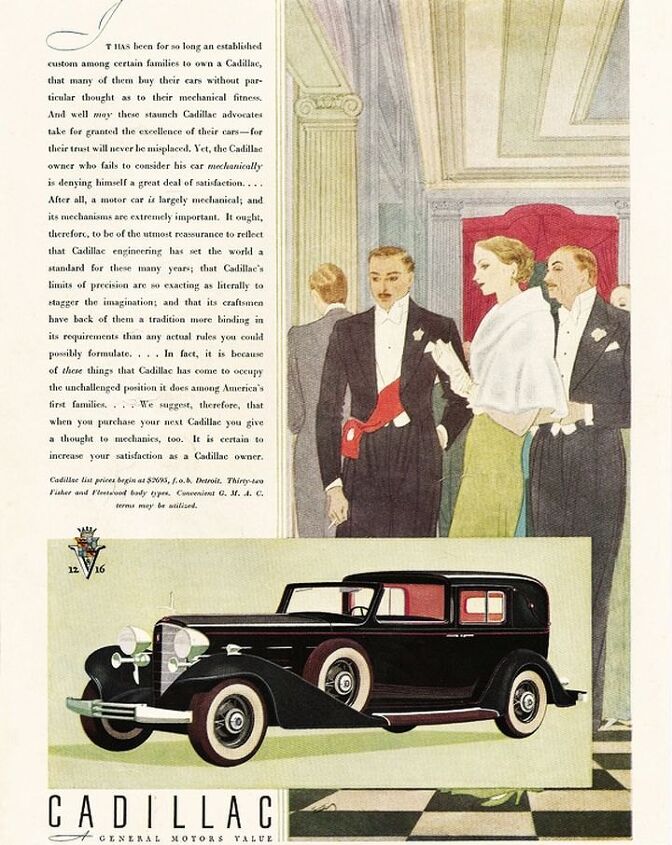Rare Rides: The 1933 Cadillac V-16 All-weather Phaeton

In the midst of the Great Depression, Cadillac offered a new range of ultra-expensive motorcars that featured 16-cylinder engines – a count never offered previously by a domestic automaker. One of the V-16’s most prestigious variations is today’s Rare Ride.
Presenting the extremely exclusive All-weather Phaeton sedan.
Customers could choose from among 10 different body styles, built by the coachbuilders in and around Detroit. Each firm assembled their bodies atop a wooden frame. Available body styles included five- and seven-passenger sedans and limousines, convertibles and coupes for two, larger coupes that carried five, as well as town car styles for five or seven, and large convertible sedans (phaetons). Pictured above is the Brougham, where your hired driver sat outside because they were poor. Customers consulted with their Cadillac dealer to personalize the V-16 in almost innumerable ways, adding their own personal sense of style inside and out.
The first run of V-16 cars was from 1930 to 1937, and Cadillac sold around 3,800 in total. For the 1933 year in particular, 126 cars were built. A second generation V-16 debuted for 1938 and merged Cadillac’s prior V-12 and V-16 engines into a singular offering in the newly-designed 7.1-liter V-16. As WWII heated up, production ended in December 1939 with less than 500 second-gen V-16s completed. It was the only time Cadillac made a production V-16 engine.
Today’s Rare Ride started out in life with a standard Fleetwood-built sedan body. Through a couple of owners, this car made its way from New Jersey to St. Louis in the Sixties. There, it had its sedan body swapped with an original All-weather Phaeton body from the same model year. It was then restored to the highest order and kept in pristine condition since. In beautiful navy over navy, the Cadillac sold recently for an undisclosed sum.
[Image: Cadillac]

Interested in lots of cars and their various historical contexts. Started writing articles for TTAC in late 2016, when my first posts were QOTDs. From there I started a few new series like Rare Rides, Buy/Drive/Burn, Abandoned History, and most recently Rare Rides Icons. Operating from a home base in Cincinnati, Ohio, a relative auto journalist dead zone. Many of my articles are prompted by something I'll see on social media that sparks my interest and causes me to research. Finding articles and information from the early days of the internet and beyond that covers the little details lost to time: trim packages, color and wheel choices, interior fabrics. Beyond those, I'm fascinated by automotive industry experiments, both failures and successes. Lately I've taken an interest in AI, and generating "what if" type images for car models long dead. Reincarnating a modern Toyota Paseo, Lincoln Mark IX, or Isuzu Trooper through a text prompt is fun. Fun to post them on Twitter too, and watch people overreact. To that end, the social media I use most is Twitter, @CoreyLewis86. I also contribute pieces for Forbes Wheels and Forbes Home.
More by Corey Lewis
Latest Car Reviews
Read moreLatest Product Reviews
Read moreRecent Comments
- El scotto Dale Carnegie had his grandkids do some upgrades?
- El scotto Work it backwards. How many people use Tesla Super Chargers: Primary Charging Point - this is my normal charging station; Secondary charging station - at a retail location or planned on trips, Rarely or Not at All.
- FreedMike Some clarification would make sense here: Tesla is laying off the team responsible for BUILDING NEW Supercharger stations. Apparently the ones already being built are going to be completed. The folks who maintain the current network are apparently unaffected. https://www.nytimes.com/2024/04/30/business/tesla-layoffs-supercharger-team.htmlAlso, many other other manufacturers are switching to NACS in the upcoming years, and some of those companies are already providing Supercharger adaptors for their non-NACS vehicles. Some Superchargers can already accomodate non-Tesla vehicles with a built in adaptor called the "magic dock."Given all this, my guess? They're trying to maximize utilization of the current system before building it out further.
- Dartman Damn Healey! You can only milk a cow so many times a day! Don’t worry though I bet Flex, 28, 1991, and all the usual suspects are just getting their fingers warmed up!
- FreedMike Your Ford AI instructor:


































Comments
Join the conversation
That was very interesting, and so is the Hyman website. Thank you for that Corey. As to the perceived decline in quality, that website provides a brief timeline. The Fleetwood they have listed from the 40s already shows aspects of mass production that reduce the apparent quality of the cars. More years ago than I care to think, I drove for a livery company which had a series of Cadillac Fleetwood 75s when Cadillac still made limousines. The rear interior of the '66 was lined with real, if dour, wood. The 70s were obviously and cheerfully plastic.
Well you don't have to worry about horrible interiors on today's new vehicles you can have any interior color on most vehicles so long as its black and a wide variety of whites, blacks, grays, and silvers for exterior colors.